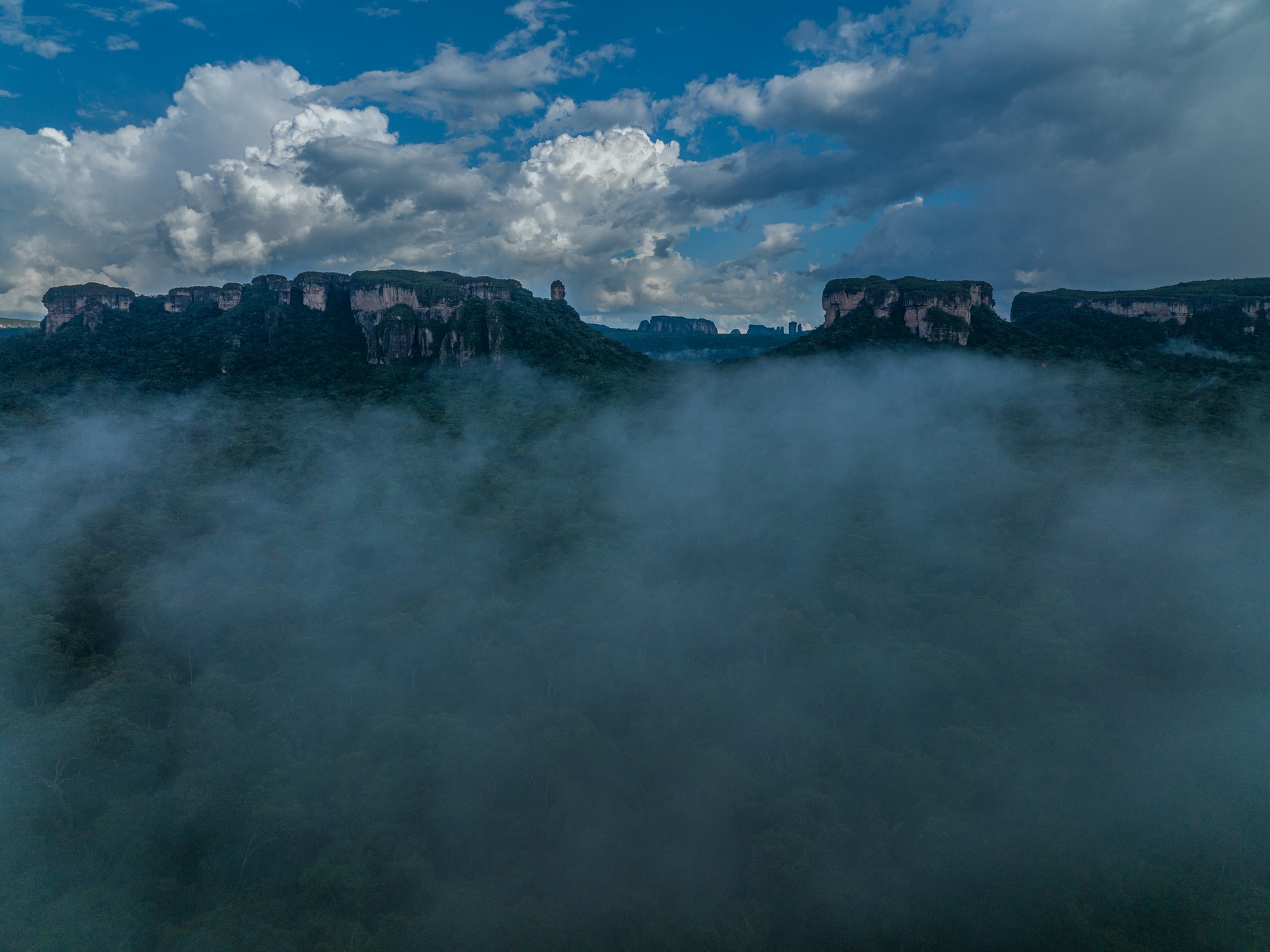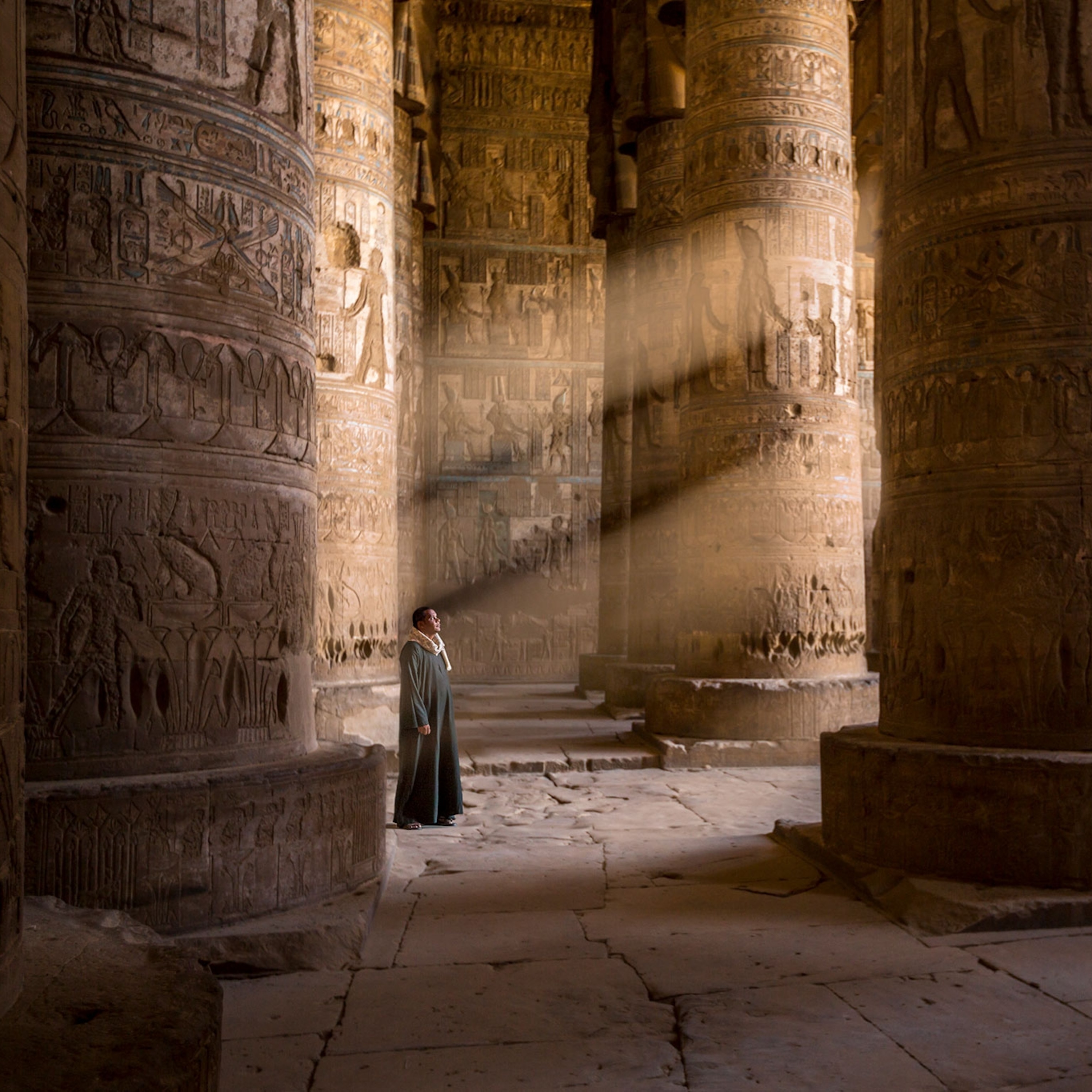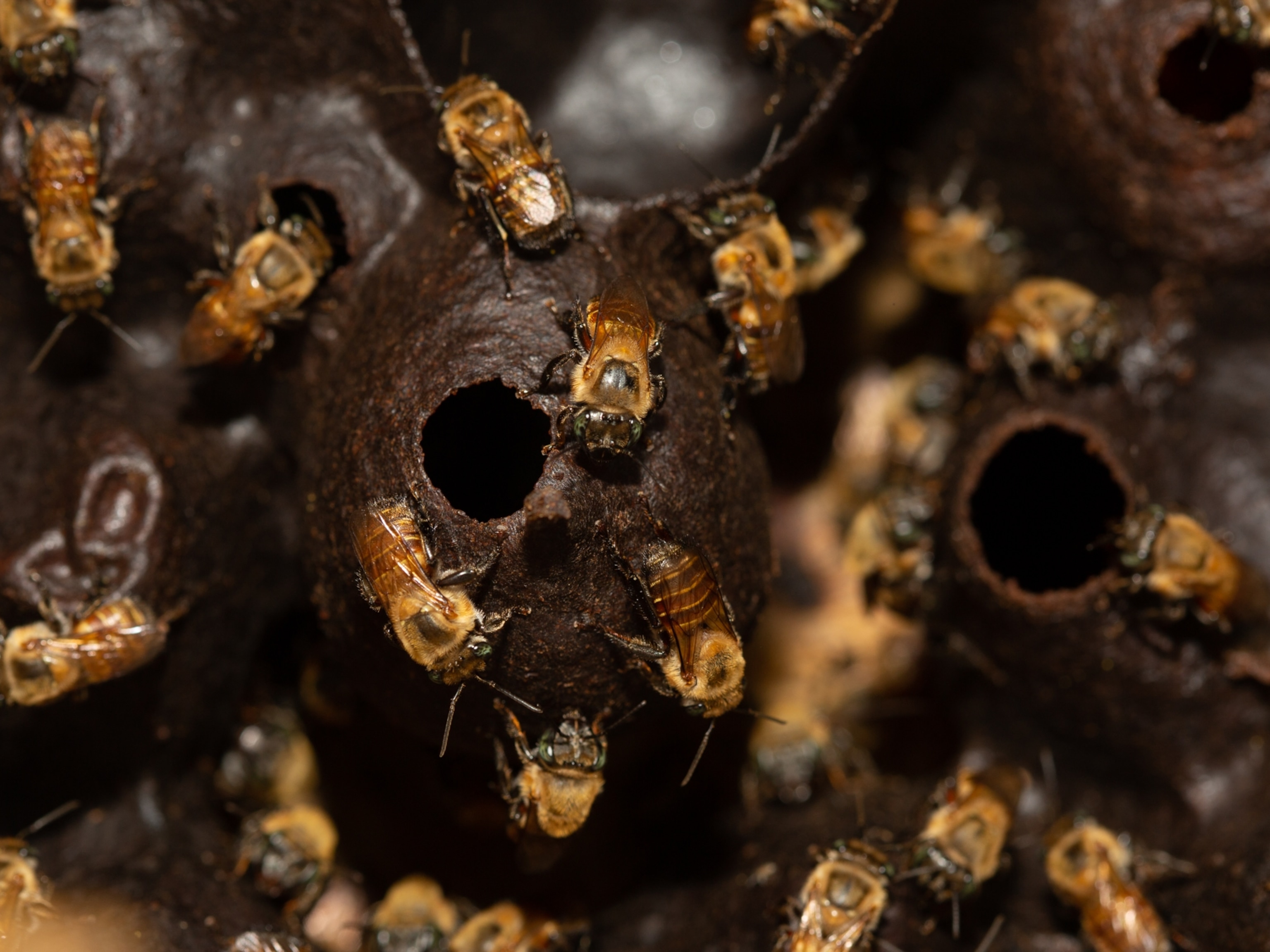Rarely seen cliff art reveals the majesty of the Amazon’s aquatic realm
In a two-year expedition, a National Geographic photographer is documenting the mighty river and the greater ecosystem from the Andes to the Atlantic.

Two jaguars leap into the river, lunging at pacas. These oversize rodents, with blotched and striped coats, are agile swimmers. Piranhas, attracted by the commotion, hover nearby.
I’m photographing this riveting scene, but I’m not underwater as I usually am when I’m on assignment. Instead of diving to see this aquatic life, I’ve climbed to a rocky ledge far above a rainforest. The jaguars, pacas, and piranhas are not flesh and blood; they are prehistoric artworks painted with hematite, a blood-red iron oxide, in exquisite detail. I am in awe, as if seeing the ceiling of the Sistine Chapel for the first time.

These pictographs in Colombia’s Chiribiquete National Park, tens of thousands of years old, are evidence of humankind’s long relationship with the world’s greatest freshwater ecosystem. I’m part of the National Geographic and Rolex Perpetual Planet Amazon Expedition, working closely with other National Geographic Explorers doing critical research in the hope of securing the future of this watery realm, which has been neglected by science and the media.
The rainforests, an essential and endangered counterweight to climate change, have overshadowed the mighty river. From the Andes to the Atlantic, the Amazon flows for 4,150 miles, the main artery of a web with more than a thousand tributaries and tens of thousands of streams in an area the size of Australia. For two years, I will photograph the river, from high in the mountains to far out into the ocean. Unlike most storytellers who have ventured here, I will dive below the surface to reveal a rarely glimpsed aquatic underworld.

A few months ago, I photographed at my geographical starting point, the peak of Nevado Mismi in southwestern Peru, the farthest point from the Amazon’s mouth, where the waters flow uninterrupted all year. I’m in Chiribiquete to explore a different type of beginning and origin.
Here, the Amazon’s first storytellers painted the most ancient visual stories ever found in the Americas. More than 75,000 paintings have been discovered in more than 70 murals, cementing the park as the Louvre of rock art in the Americas. The pictographs include fauna and flora, people, and geometric patterns. Jaguars, sometimes life-size, are one of the most common motifs—each with a unique pattern of rosettes or lines.



I am with a small team, which includes aquatic biologist and National Geographic Explorer Fernando Trujillo and archaeologist Carlos Castaño-Uribe. A group of Colombian climbers and jungle specialists is with us so we don’t get lost in the trackless wilderness. We are only the ninth expedition to be granted permission to explore Colombia’s largest park, which protects a spectacular landscape of dense rainforest and soaring tabletop mountains called tepuis.
For 25 years I have documented our planet’s wildest seas, first as a marine biologist and later as a photojournalist. I am well versed in how not to get bitten by a shark or crushed by a feeding whale, but I am a neophyte in the jungle. In my defense, Chiribiquete is an incredibly difficult place to explore, and the ancient artists chose some of the most inaccessible locations.
A challenging landscape
The helicopter takes off from the small airport of San José del Guaviare in south-central Colombia; the landscape below is a patchwork of cattle pastures and grasslands. Finally an unbroken carpet of pristine rainforest rolls out to the horizon. When the first mountains appear, the pilot descends, and we navigate through canyons so narrow that I can almost reach out and touch the cliffs. We land on a scrap of uneven rock. The helicopter barely fits.
The location appears idyllic, but it feels as if we’ve set up camp on a furnace. As the sun heats the rock, it bakes the air in our tents to more than 100 degrees Fahrenheit. I try to fall asleep, desperate for a breeze. My sweat forms wetlands on my mattress.


We wake to the sound of tens of thousands of tiny helicopters. The sweat bees are here. Soon the entire camp—camera cases, boots, clothing, plates, cutlery, anything left outside—is draped in bees. I make the mistake of leaving my tent zipper slightly cracked and before long end up with dozens of roommates. I let the bees quench their thirst from the sweat lake in my belly button. Resistance is futile. The bees overwhelm us. They crawl into our noses and ears; one even slips beneath my eyelid. A head net becomes mandatory.
The lowlands adjacent to rivers that flow through the park have hardly any sweat bees, but we were advised not to stay there. Remnants of FARC rebel forces are said to use these rivers when the water is high enough. I prefer bees to AK-47s.
Once, on an expedition in 2017, Trujillo woke in the early hours of the morning to the sound of footsteps. Thinking it was another researcher, he went back to sleep. The next morning, the scientists discovered smaller footprints, barefoot, in step with their boot prints. Indigenous Karijona, Murio, or Urumi people—uncontacted or living in isolation since violent encounters with rubber tappers in the 1800s—inhabit the headwaters of the park’s most important rivers. More than 50 miles of difficult terrain separate them from our campsite, but before falling asleep, I listen intently for the rustle of leaves or the crack of a twig.


In the 1940s, Harvard ethnobotanist Richard Evans Schultes was the first scientist to note what he called Indian paintings on Chiribiquete’s cliffs. But he didn’t realize he was surrounded by one of the most extensive rock art repositories. This became apparent only in the 1980s when a storm pushed Castaño-Uribe’s Cessna off course and he spotted a mountain range that wasn’t on any of his maps. He returned to explore, saw the pictographs, and decided to devote his life to Chiribiquete. Not only did he publish the first detailed descriptions of the paintings and connect them to Indigenous cosmology, but he was also instrumental in the park’s establishment in 1989, expansions in 2013 and 2018, and selection as a UNESCO World Heritage site in 2018.
The oldest paintings here have been radiocarbon-dated to 20,000 years ago, but the youngest are from the 1970s, and compelling evidence shows that some are even more recent. On another expedition, Castaño-Uribe found a small hearth with animal bones and pigments beneath some paintings, indicating the art continues to be meaningful in Indigenous cosmology and ceremonial activities.
Hacking, hiking, rappelling
Before our expedition began, Castaño-Uribe consulted a shaman in the Sierra Nevada de Santa Marta, a mountain range near the Caribbean coast. To ensure a safe return and appease the spirits of the sites, the shaman advised him that we should make an offering of tobacco—sacred to many Amazonian Indigenous groups—before approaching the paintings. At the base of a sandstone tower, Castaño-Uribe passes around fat cigars that would not look out of place during a poker game. We puff vigorously, bathe ourselves in smoke, place our palms on the rock, and earnestly state our intentions. For extra measure, Castaño-Uribe exhales smoke over each of our heads.
Only then do we begin to explore.

After hours of hacking through dense foliage, a dark canyon spits us out onto a narrow ledge next to a vertical cliff. We are at a site named “Los Gemelos” (“The Twins”). The rock art depicting stingrays, otters, and turtles is magnificent—and fiercely protected by bees. This time not the annoying stingless sweat bees but more virulent honeybees.
In less than half an hour the team collectively endures more than a hundred stings. We retreat, but the bees follow, and a rock wall that requires a fixed rope to climb becomes a bottleneck. Castaño-Uribe and I are waiting when he decides he has had enough of being stung. He bypasses the rope and, in a crouched run, scales the near-vertical 30-foot cliff, leaping from tree root to tree root, from branch to branch, Tarzan style. Not wanting to be left to the mercy of the belligerent bees, I follow, and despite being 15 years younger, I struggle to keep up.
Every morning we set out by helicopter and then on foot, climbing steep and densely forested slopes, rappelling down cliffs, and hauling ladders to navigate dark and damp canyons. Less than a half hour into one ascent I am close to collapsing because of my armored fashion choices. I’m layered up with thick combat pants, two shirts, gloves, a head net, and a pair of snakebite gaiters. I will do whatever it takes to protect myself from enemies, both real and imagined.


The ferocious sting of bullet ants, a whopping 4 on the Schmidt pain index, is described as akin to walking across hot coals with a three-inch nail embedded in your heel. The potentially lethal fer-de-lance is responsible for most of the snakebites in the Amazon region. The bite of a female phlebotomine sand fly could infect me with disfiguring leishmaniasis. With every labored step in the stifling heat, I ask myself again and again what I’m doing in the Amazon.
I remind myself that this is just one chapter in my journey. Soon I will be back in my element, underwater, photographing species that are so outlandish that they could have been extras at the Star Wars cantina. Pink dolphins use sonar to navigate flooded woodlands. The arapaima, an armored fish that weighs as much as a silverback gorilla, leaps from the water like a marlin. Electric eels, like swimming batteries, deliver 600-volt shocks powerful enough to kill a human. Black freshwater stingrays with bright yellow spots rest in the leaf litter of drowned forest floors.

My National Geographic Explorer collaborators include some of the Amazon’s most accomplished scientists: Fernando Trujillo, João Campos-Silva, Ruthmery Pillco Huarcaya, Angelo Bernardino, Thiago Silva, Baker Perry, and Hinsby Cadillo-Quiroz. They’re doing groundbreaking work on pink dolphins, arapaimas, spectacled bears, mangroves, flooded forests, climate change, and mercury pollution. Next year, National Geographic will devote an entire issue of the magazine to the Amazon, featuring my photographs and their studies.
Finding inspiration from the earliest Amazon artists
Famed 19th-century naturalists like Henry Walter Bates, Alfred Russel Wallace, and Alexander von Humboldt produced beautiful illustrations of what they had seen on their explorations in the Amazon River Basin. But I came to Chiribiquete to see the work of the first people in the Amazon to depict fauna and flora, specifically the aquatic animals I hope to photograph. On sheer rock walls, they painted fish, turtles, caimans, and other life-forms.
Over our five days in Chiribiquete, we saw hundreds of pictographs. The “Hojarasca” (“Fallen Leaves”) panel, with jaguars hunting pacas among piranhas, spoke to me the most. The way they’re painted on an overhang evoked the sense that I was underwater looking up as the scene played out above.

Castaño-Uribe thinks these paintings were likely made by shamans and played a role in religious rituals. Through the ingestion of sacred plants, Baniwa shamans believe they can transform into jaguars and talk with spirits. To the Tikuna, pink dolphins are sacred, feature in their dances, and are said to dwell in malocas, or longhouses, at the bottom of the river. Anacondas are often considered the creators of the universe, and a Desano legend tells of a giant snake that ascended the Amazon carrying the ancestors of all mankind on its back.
The shamans likely painted to communicate with supernatural beings to ensure balance between humans and the rest of nature. I tell stories because our relationship with Earth’s biodiversity urgently needs recalibration. The Amazon’s aquatic world is threatened by dams, mining, overfishing, pollution, and climate change. Gazing at these vivid, timeless pictures, I feel deeply connected to these artists and their paintings. I realize we are telling similar stories, and I hope my images stand the test of time even a fraction as well as theirs.
A version of this story appears in the July 2023 issue of National Geographic magazine
Related Topics
You May Also Like
Go Further
Animals
- How scientists are piecing together a sperm whale ‘alphabet’How scientists are piecing together a sperm whale ‘alphabet’
- Orangutan seen using plants to heal wound for first timeOrangutan seen using plants to heal wound for first time
- What La Palma's 'lava tubes' tell us about life on other planetsWhat La Palma's 'lava tubes' tell us about life on other planets
- This fungus turns cicadas into zombies who procreate—then dieThis fungus turns cicadas into zombies who procreate—then die
Environment
- The northernmost flower living at the top of the worldThe northernmost flower living at the top of the world
- This floating flower is beautiful—but it's wreaking havoc on NigeriaThis floating flower is beautiful—but it's wreaking havoc on Nigeria
- What the Aral Sea might teach us about life after disasterWhat the Aral Sea might teach us about life after disaster
- What La Palma's 'lava tubes' tell us about life on other planetsWhat La Palma's 'lava tubes' tell us about life on other planets
- How fungi form ‘fairy rings’ and inspire superstitionsHow fungi form ‘fairy rings’ and inspire superstitions
- Your favorite foods may not taste the same in the future. Here's why.Your favorite foods may not taste the same in the future. Here's why.
History & Culture
- These were the real rules of courtship in the ‘Bridgerton’ eraThese were the real rules of courtship in the ‘Bridgerton’ era
- A short history of the Met Gala and its iconic looksA short history of the Met Gala and its iconic looks
- Meet the ruthless king who unified the Kingdom of Hawai'iMeet the ruthless king who unified the Kingdom of Hawai'i
Science
- Why trigger points cause so much pain—and how you can relieve itWhy trigger points cause so much pain—and how you can relieve it
- Why ovaries are so crucial to women’s health and longevityWhy ovaries are so crucial to women’s health and longevity
Travel
- What it's like trekking with the Bedouin on Egypt's Sinai TrailWhat it's like trekking with the Bedouin on Egypt's Sinai Trail







